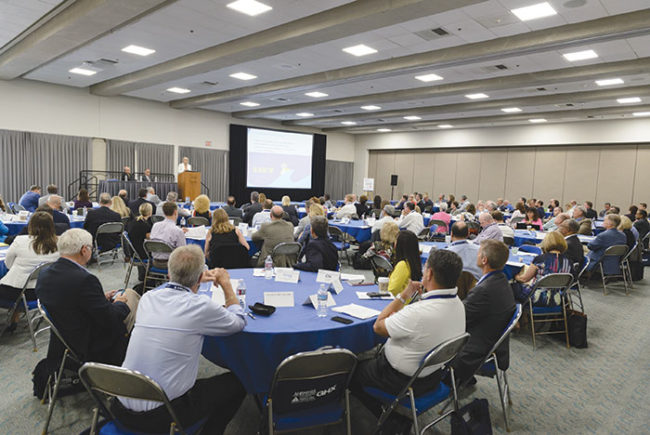The rate of health care mergers and acquisitions (M&A) has increased significantly, with 95 or more hospital transactions occurring in the United States each year from 2012 through 2014, according to an analysis by Kaufman, Hall & Associates.
In fact, last month’s Health Facilities Management/American Society for Healthcare Engineering (ASHE)/Association for the Healthcare Environment Salary Survey found that nearly one-third of respondents work at a facility that has been involved in M&A activity over the past three years.
You may also like |
| Infrastructure planning for off-site operations |
| Benchmarking energy performance |
| Benchmarking chiller and boiler efficiency |
| |
Facility managers who have not yet participated in a merger or acquisition should be prepared to do so and be change leaders in their organizations, advises Leo M. Gehring, CHFM, CHC, FASHE, the 2007 president of ASHE and a consultant based in Little Rock, Ark.
“The No. 1 thing facility managers need to learn is that mergers and acquisitions happen for positive reasons, not for negative reasons,” Gehring emphasizes. Facility directors with a track record of championing efficiency, financial responsibility, and patient safety and satisfaction in their organizations will be positioned to thrive after the announcement of a merger or acquisition and be better able to adapt to new procedures and standards, he says.
What to expect
Change after a merger or acquisition is inevitable, but it doesn’t happen overnight. When rapidly growing Geisinger Health System acquires a hospital or health system, new signage will be in place on the first day the health facilities are officially part of Geisinger. But it can take more than a year to bring the acquired organization’s information technology (IT) systems up to speed.
“The first task when absorbing these organizations is to get the IT converted to our IT systems,” says Al Neuner, CHFM, vice president of facilities operations for Danville, Pa.-based Geisinger, which has nine hospital campuses in Pennsylvania. “Sometimes we’re a year or two down the road before we can roll out all of our programs, including our maintenance management systems, our building database systems, and our policies and procedures, because we don’t have the organization’s IT on our network yet.”
During periods of waiting or uncertainty after a merger or aquisition announcement, facility managers should step up to the plate and demonstrate their competence and knowledge of the business of health care, urges Gehring, who has 45 years of experience in health facilities management. “We need to get away from the boiler house mentality — the assumption that if we know everything there is to know about boilers, we’ll be perceived as winners and be successful in our careers,” he says.
Assessing the situation
When Englewood, Colo.-based Catholic Health Initiatives (CHI), which owns and operates 105 hospitals in 19 states, acquires a hospital or health system, the organization conducts a total quality evaluation of the newly added facilities, says George A. “Skip” Smith, CHFM, SASHE, CHI’s vice president of physical asset services.
“We go in and assess the entire program, including the operations and the competencies of staff,” says Smith, who was ASHE’s 2011 president. “We review their capital budgets. And we go through every one of the Joint Commission’s standards and make sure the facilities are compliant.”
After the first evaluation, facility directors have 18 months to fix any problems under their jurisdiction. “Our evaluation is scored on a scale of 1 to 100,” Smith explains. “If they get a 60 the first time, we expect that the next time, they will be over 90.
“We don’t penalize them the first time because often they don’t have the experience, the training or the resources,” he continues.
Smith notes that CHI will provide assistance to underperforming facilities, such as bringing a top-notch facility director from another site to help out, providing management plans and other templates, and reviewing potential plans before their implementation. “They will get resources they didn’t have before,” he says.
When a robust health system purchases a struggling hospital or group of hospitals, facility managers at the acquired institutions should anticipate that more attention will be paid to environment of care and infection control standards, Gehring says. That added scrutiny should be viewed favorably, he maintains.
One potential target for close inspection after a merger or acquisition is air flow, which is critical to preventing health care-associated infections. Gehring points out that the Joint Commission recently has been focusing on improving compliance with isolation room air-pressurization standards, which more than half of its accredited hospitals fail to meet.
Patients with highly infectious diseases should be in negatively pressurized rooms to prevent pathogens from escaping, whereas immunocompromised patients should be in positively pressurized rooms to keep contaminants away. Although facility managers should be familiar with these basic principles, they frequently do not effectively monitor air pressure, Gehring contends.
“Right now, 53 percent of hospitals are getting findings on that,” he says.
Gehring suggests that a simple Baulin tube inserted in the wall would make it easy for staff to visually determine whether a room is appropriately pressurized. More elaborate pressure monitoring and alarm systems can be implemented as well.



